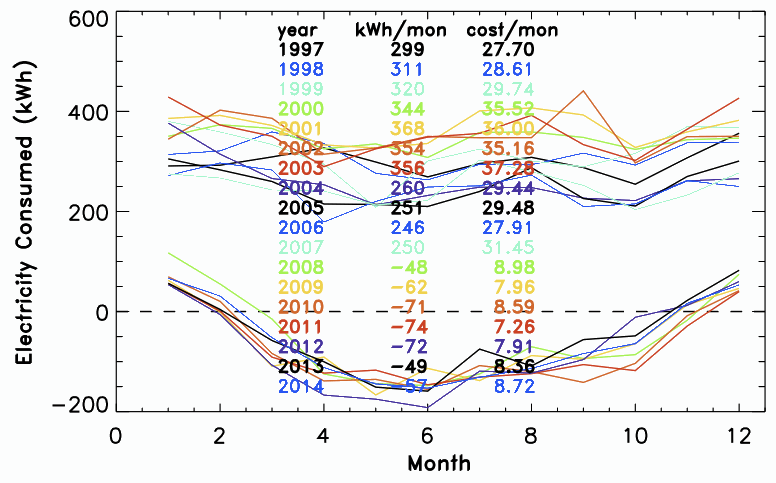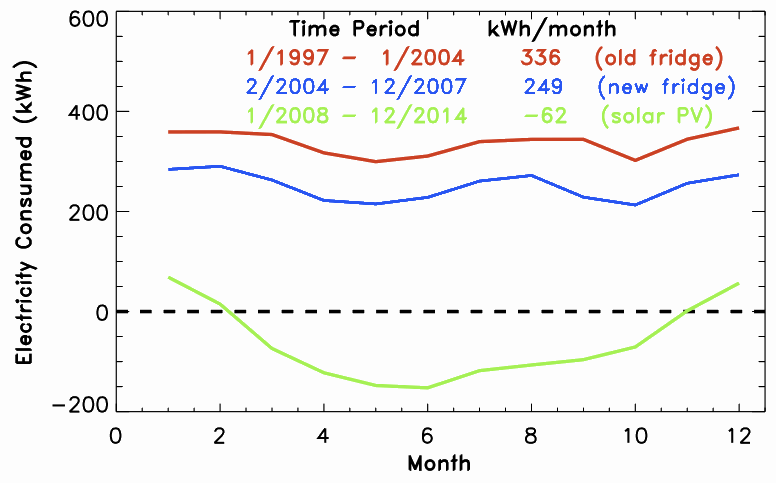- Home | About
- • Personal Energy Stories •
- My Solar PV System
- The Refrigerator Story
- Lighting Choices
- Lessons from an Energy Meter
- Opt Out of Mail / Phonebooks / etc
- • Essays & Articles •
- Global Warming in a Nutshell
- Power and Energy in a Nutshell
- Why Move Beyond Fossil Fuels?
- • Local Programs •
- EnergySmart - Boulder County
- Longs Peak Energy Conservation
- Borrow an Energy Meter
- • Useful Links •
- TopTenUSA.org / Enervee.com
- DSIREusa.org
| Electricity Use 1997-2009: Effect of Solar Panels and New Refrigerator |
| Monthly Electricity Use in kWh | Monthly Electricity Use Over Multi-Year Periods |
|---|---|
 |
 |
| This figure shows my electricity use in kWh for each month over the period 1997-2009. The numbers are the average monthly kWh consumed each year, calculated by adding up the kWh for all months of the year and dividing by 12. The average monthly cost of electricity in dollars is also shown, but cost isn't as informative as kWh because cost also includes variability in the price of electricity and the various taxes and fees. Since each billing cycle includes a different number of days (usually 28-33), I adjusted ("normalized") the numbers to all represent a 30-day month.
Before the solar panels (1997-2007), I used 250-350 kWh/month on average. There are some hints of seasonal variability (higher in winter and late summer, lower in spring and fall), and these trends are more clear in the next figure. After the solar panels (2008-2009), I produced on average about 50 kWh/month more electricity than I consumed, and that excess was sold to Xcel and put onto the grid. The 2008 and 2009 curves show that during Dec-Feb my panels don't produce as much electricity as I consume, so I need to buy 50-100 kWh/month from Xcel. |
This figure shows the same data as the figure at left, except that periods of several years are averaged together in order to reduce the year-to-year variability and bring out trends that relate to major changes in my electricity use. The red curve (1997-2004) and the blue curve (2004-2007) are the time periods before and after I replaced my older energy-hog refrigerator (a classic 1980s gold model) with a more efficient one, even though my old fridge was not broken. Replacing the fridge led to a permanent decrease in electricity use of 87 kWh/month (1044 kWh/year), or 26% of my previous electricity use. At an electricity price of 10¢/kWh, the new fridge saves about $100/year in electricity, and it paid for itself by 2010. Now I have a newer, nicer refrigerator for free, and I'll continue to save $100/year in electricity. Plus, I would have needed 3.7 more solar panels (MUCH more expensive than a new fridge) in order to make the extra 1000 kWh/year that the old inefficient fridge just converted into waste heat that was dumped into my kitchen. Finally, the unnecessary 1000 kWh/year needed to power inefficiency required the mining and burning of 750 pounds of coal per year, which put 2750 pounds of carbon dioxide per year into the atmosphere, all for less than no useful purpose.
What to do with a still-working older refrigerator? Some utilities have an Appliance Recycling Program. or retailers may offer to cart it away for free when they deliver the new one (it's worth asking what they will do with it). There may still be life in the old fridge, but selling or even giving it away just saddles someone else with an energy hog (so give it to an enemy, not a friend). I'd recommend putting it beyond use by smashing holes in the inside before sending it to an appliance recycler. That's a difficult recommendation from someone who is philosophically opposed to pointless waste, but it's not necessarily pointless to waste an inefficient refrigerator. Instead, it's a selfless humanitarian gesture to eliminate from the Earth the pointless mining and burning of coal and release of carbon dioxide into the atmosphere. |